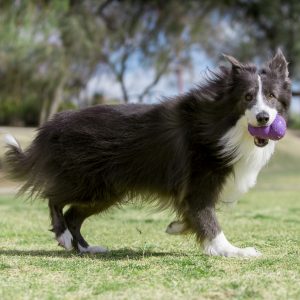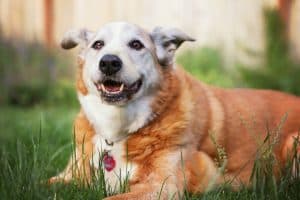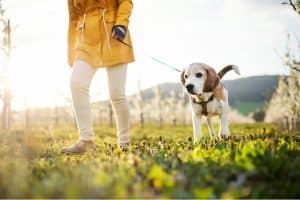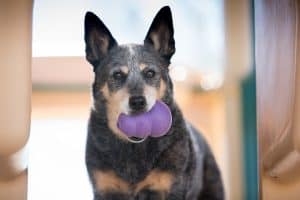
7 Tips For Exercising Senior Dogs
It’s estimated that 26.5 million US households are home to senior dogs. If you are in one of those households, you may notice that your dog is starting to slow down. As dogs age, their exercise needs change and a more tailored approach to keeping them happy and healthy is necessary.
Dr. Linda Simon, a member of the British Royal College of Veterinary Surgeons, explains, “A lack of exercise can quickly lead to muscle atrophy and dogs will be prone to injuries if they do suddenly sprint or jump, as their joints won’t be as well equipped to deal with the load.”
Senior dogs need to keep moving to prevent stiffness and maintain muscle mass but how can you do that effectively when your dog’s energy levels are not what they used to be?
TIPS FOR KEEPING YOUR SENIOR DOG ACTIVE
1. ADJUST THE INTENSITY ACCORDINGLY
“We cannot expect to continue with the same exercise regime for all of our dog’s life,” explains Dr. Simon. “We need to dial it down once they enter their senior years, to prevent overexertion and to ensure they can safely keep up.”
Keep an eye on your dog’s energy levels during exercise and watch for signs that they need a rest. Make sure your dog isn’t struggling to keep up with your walking pace. If this is the case, begin reducing your speed until your dog is walking at a comfortable pace for them.
2. SWITCH TO SHORTER, MORE FREQUENT WALKS
Most dogs love a stroll outside and that doesn’t stop when they enter their golden years. However, it’s important to be consistent and not to overdo it. Dr. Simon often notices that dog parents will bring their old dogs for long hikes on the weekend and short strolls around the block during the week. She notes that this kind of pattern makes injuries at the weekend much more likely.
3. CHOOSE SOFT SURFACES
“Softer surfaces like grass, sand, and soil are perfect to protect joints as they act as a shock absorber,” notes Dr. Simon. “Walking fast or running along hard surfaces can ‘jar’ the joints, making injuries and arthritis flare-ups more likely.”
It’s important to avoid repetitive movements that can put stress on a dog’s joints, such as jogging on a hard sidewalk.
4. INCLUDE LOW-IMPACT EXERCISES
Incorporate gentle activities like swimming into your dog’s exercise regime. Swimming is great for senior dogs because the reduced pressure on their joints means they can use them to their full flexion and extension with minimal risk of injury.
KONG offers a wide variety of water toys that can make your senior pup’s exercise much more fun. From retrieving toys to squeaky toys, your senior dog will be sure to find something they love to take swimming.
5. FOCUS ON MENTAL STIMULATION
Dr. Simon explains, “As dogs get older, it has been proven that keeping them stimulated mentally can prevent canine dementia and slow its development. This can include things like food puzzles, mini-training sessions, and games. Older dogs enjoy this interaction, and it can stave off anxiety and boredom.”
If your dog has loved their trusty KONG toy stuffed with all their favorite treats, then the KONG Senior is perfect for keeping them mentally stimulated in their golden years. The KONG Senior is made from rubber which is customized for an aging dog’s chewing and play needs.
6. CONSIDER A DOG STROLLER
“Dog strollers can be useful for those who cannot keep up when we need to take a longer walk,” explains Dr. Simon. “It may be you have to exercise your younger pooch or have chores to carry out a distance away from home. Rather than forcing your dog to over-exercise, a dog stroller is a great compromise, and they can hop in once they’ve done their exercise for the day.”
7. CONSULT WITH YOUR VETERINARIAN
Dr. Simon advises that senior dogs are seen every 6 months at a minimum, for a general check-over. This is especially true if you’re concerned about joint disease or feel your dog is not keeping up on their walks.
You and your vet can discuss environmental management and exercise to keep your dog healthy. Many dogs also benefit from medicine such as pain relief and anti-inflammatories, which can improve their quality of life.
 COMMON SENIOR DOG AILMENTS THAT CAN AFFECT EXERCISE
COMMON SENIOR DOG AILMENTS THAT CAN AFFECT EXERCISE
Knowing the common types of ailments that can affect a senior dog’s exercise abilities can help you tailor your dog’s exercise to meet their individual needs.
“The most common musculoskeletal issues I see in seniors include arthritis, spondylosis, and hip dysplasia,” notes Dr. Simon. “Many dogs will also have old knee injuries, including worn and partially torn cruciate ligaments or luxating kneecaps.”
Other ailments such as heart disease, chronic bronchitis, and tracheal collapse are all examples of medical issues that make it harder for a dog to exercise. This is because these conditions make it difficult for a dog’s body to keep up with increased oxygen requirements caused by exercise.
FINAL THOUGHTS
Every senior dog is unique, and their exercise needs will differ based on their energy levels, health conditions, and individual preferences. Whilst these tips offer a starting point, observing your dog’s responses and consulting with your vet for a tailored exercise plan is ideal.
Incorporating these tips into your senior dog’s routine can make a significant difference in their health and happiness as they enjoy their golden years by your side.
 from Hannah Fitchett
from Hannah Fitchett





